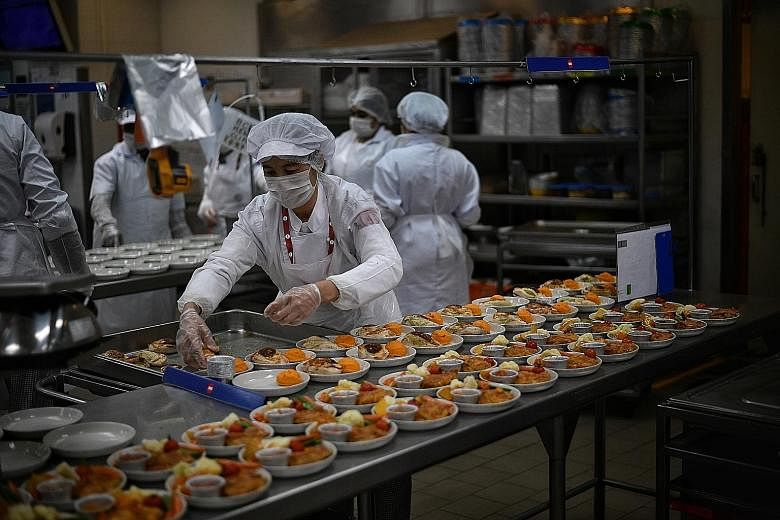At 30,000 feet, when taste buds "die" and the sense of smell nosedives, when the mucus in your nose hardens and the air is dry, scrambled eggs can taste like powder and fried rice, bland.
If you think airline food is bad, try this the next time you fly.
Eat light before take off, so avoid fried or oily food; always drink water - not alcoholic beverages - before you eat on the flight, and keep drinking every few hours.
If you must have that glass of wine or whisky, keep it to one or, at most, two.
Pick your meals wisely. Go for braised items and meals that come with some gravy. Fish, which usually stays soft and moist, is a good choice. Indian and Malay food that tend to be heavily spiced are also good options.
To understand the dos and don'ts, one must first understand what happens to the human body at 30,000 feet.
Step into an aircraft and the first thing that goes is the sense of smell.
-
WHAT SATS DISHES OUT IN ONE DAY
-
80,000 meals
86,000 pieces of bread
10 tonnes of vegetables
3.5 tonnes of meat/fish
900 litres of chicken stock
5,000 eggs
1.5 tonnes of egg pulp for omelettes, frittata, pastry
2.4 tonnes of cooked rice
1.8 tonnes of watermelons
As the plane climbs higher, air pressure drops and humidity falls to 8 to 20 per cent - drier than in a desert. On a normal day in Singapore, humidity is about 80 to 90 per cent.
The aircraft cabin is typically kept at about 20-21 deg C, which makes the atmosphere even more dry.
All this has an impact on how food tastes in the air, said third-generation chef and former restaurant owner Rick Stephen, 60. The Australian is now director of kitchen at ground handling firm Sats.
The same meal, if consumed on the ground, tastes much better, he guarantees. "A glass of wine that tastes okay on the ground is terrible on a flight. Same with salty food that turns bland in the air," he said.
Travellers cannot control their taste buds and other senses during a flight but they can help themselves by staying hydrated and following the simple guidelines mentioned earlier, he told The Sunday Times as he walked the team through his kitchen at Changi Airport, which whips up about 45,000 meals a day.
A second kitchen at Changi North produces about 35,000 daily meals.
"A lot of people take alcohol, which causes dehydration... I have water and tea, and then I have the alcohol," he quipped.
On a more serious note, Chef Rick, as he is referred to in his kitchen, stresses that a tremendous amount of research and testing is done to make in-flight meals pleasant for as many passengers as possible.
Sats is believed to be the only airline caterer that has a food-tasting chamber, which can be regulated to simulate an actual aircraft cabin at 30,000 feet. It comes complete with ovens and other equipment found on board.
"When we develop new ideas and menus, we go on a 'flight' in the chamber with our airline customers. We taste the food, we come to a consensus and, if need be, we go back and tweak," he said. "We do not one, but two and sometimes even three tests, before everything is finalised. We also invite airline crew into the chamber for training."
On the ground, chefs in the different kitchens must set aside a small portion of everything that they prepare. The food is tasted at 2pm every day to ensure a consistent and high quality.
Chef Rick is the first to admit that no matter how much they do, they cannot please everyone.
"We all have different taste buds that react in different ways but here, we have to cook for the majority, unless we are doing special meals."
Those looking for authentic hawker food will also sometimes be disappointed, he said.
"Kung pao chicken is simple enough to do but if you are expecting the 'wok hei' from hor fun noodles or char kway teow, that's impossible to replicate on an aircraft," Chef Rick said, referring to the flavour that comes from cooking in a wok.
Food needs to be prepared 10 to 12 hours before a flight, moving through several processes. Once the cooking is done, the food goes into a blast chiller to bring the temperature down to 4 deg C. It is then dished and goes into the fridge for another six hours. From there, the meals are transported to the aircraft.
How it eventually ends up in front of the passenger also depends on how well the cabin crew handle the food.
Chef Rick said: "To be fair, it can be challenging for them too. They press the button on the oven, which typically runs for about 20 minutes, but if there is turbulence, for example, or some other emergency, they may not be able to remove the food when the timer goes off. The food then ends up absorbing retention heat (which can make it dry or overcooked)."
When warming bread, the rolls that come into contact with the sides of the oven can become crusty and a little hard, he said.
While there are complaints from time to time, the one thing that Sats does not compromise on is the quality of its food, Chef Rick stressed.
So, for those who are wondering, he set the record straight, proudly declaring: "We do not use powders or artificial products, so no powdered soups or sauces. Mashed potatoes are made from real potatoes and the eggs we use are real; that too, locally sourced. No imported eggs for us."


